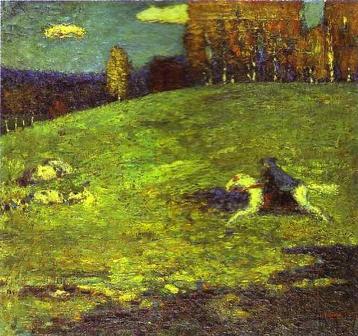Although Kandinsky’s works continued to be based primarily on landscapes, they became increasingly simplified. Many of his landscapes were still inspired by the scenery of Murnau in Bavaria, where he owned a house with his mistress, Gabriele Münter, a German painter. Beginning around 1909, Kandinsky’s personal style began to coalesce. He worked primarily in Murnau and in Munich, and began to transform shapes, lines, and colors into a “visual language” that could express general ideas and evoke deep emotions. He hoped this new “language” would be as effective as the abstract “language” he perceived in music. It was during this period that Kandinsky first began to think of painting as an alternative pathway to spiritual reality, and he began to strip away detailed elements from his works. Kandinsky also began to include large areas of vibrant color to stimulate emotions associated with classical music and to provoke responses which the considered use of specific colors could lead to. In abstraction, Kandinsky felt that he had discovered a spiritual reality which was more powerful for not being tied to the outside world – an alternative music for the senses.
This period was at its height when Kandinsky co-founded and participated in the Der Blaue Reiter (The Blue Rider) group. The rider holds a key position in Kandinsky’s art during the Munich years, representing the seeker and the herald. The rider is the symbol of embarking upon a new era, in which art opens up new spiritual worlds, guiding humans to more intense sensory experiences. The painting below, The Blue Rider (1903), showcases this tendency.

Although Kandinsky was not alone in developing his ideas of abstraction or spiritual philosophy, he remains an extraordinarily important pioneer in the nonfigurative painting genre. His main claim to historical importance has commonly been regarded as First Abstract Watercolor (1910).
However, the date of origin for this painting is now considered to be later; hence the 1913 Composition VII gains importance, as does Blue Mountain (1908) (below), in which trends toward nonrepresentation have clearly begun. The broad use of color in this painting, in which none of the figures is shown in any real detail, are illustrative of Kandinsky’s trajectory toward presenting color independently of form.

Blue Mountain (1908)
The use of the deep blue is also reflective of Kandinsky’s beliefs about the significance of different colors. For more on this topic, please see the page entitled Anthroposophy and Abstract Art.
The piece below, Murnau Mountain Landscape with Church (1910) can be contrasted with the earlier landscape of Murnau to illustrate Kandinsky’s movement from a more realistic depiction of scenery to a less figurative interpretation of colors and emotions associated with a scene.
